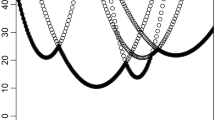The objective of this study is to improve the efficiency of achieving accurate and speedy inspection when a coordinate measuring machine (CMM) is used to measure circularity geometric tolerance. Grey prediction using grey theory was applied in developing the heuristic algorithm for predicting the number of measuring points required for measuring circularity geometric tolerance. The heuristic algorithm was used to plan the number of measuring points of the next workpiece and to predict the circularity geometric tolerance dimensions. This step provides a better foundation for on-line inspection to determine the number of measuring points required for measurement inspection of the next workpiece. It can also predict whether the circularity geometric tolerance of the next workpiece will conform with the circularity geometric tolerance dimension on the design drawing. This heuristic algorithm could also be used to determine whether the manufacturing process requires modification, in order to save human and material resources and reduce failure rate. In this paper, a circularity heuristic algorithm for deciding the number of measuring points for the circularity geometric dimension is proposed to reduce the angle between measuring points. In this heuristic algorithm, the addition of measuring points is determined by whether the predicted circularity value exceeded the scope of the grey interval. When more points are to be inspected, equiangular inspection is again performed. Once the predicted circularity value exceeds the limitation of the design drawing circularity geometric dimensions, the manufacturing process is examined immediately. The concept of adding measuring points for on-line inspection is combined with the grey prediction and the standard deviation concept to establish the circularity heuristic algorithm for deciding the number of the measuring points. Experimental data are also introduced to verify the measuring point algorithm for the circularity geometric dimension of a workpiece. The objective is to reach a balance between the smallest number of measuring points required for inspection and inspection accuracy. Consequently, it is possible to avoid using too many measuring points, which increases the inspection time, while achieving the required measurement accuracy. using too many measuring points, which increases the inspection time, while achieving the required measurement accuracy.
Similar content being viewed by others
Author information
Authors and Affiliations
Rights and permissions
About this article
Cite this article
Lin, ZC., Lin, WS. The Application of Grey Theory to the Prediction of Measurement Points for Circularity Geometric Tolerance. Int J Adv Manuf Technol 17, 348–360 (2001). https://doi.org/10.1007/s001700170170
Issue Date:
DOI: https://doi.org/10.1007/s001700170170




